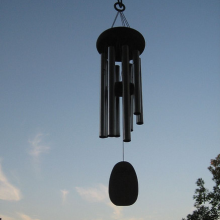 I have a set of wind chimes hanging from an arbor that catch my attention whenever I am out in the garden and the breeze kicks up. They were given to me by Mrs. Mary Marlboro’s niece. Mary had purchased them while in hospice with instructions for her niece to give them to me after she passed on. I had cared for Mary for several years after I removed her larynx because of a cancer.
I have a set of wind chimes hanging from an arbor that catch my attention whenever I am out in the garden and the breeze kicks up. They were given to me by Mrs. Mary Marlboro’s niece. Mary had purchased them while in hospice with instructions for her niece to give them to me after she passed on. I had cared for Mary for several years after I removed her larynx because of a cancer.
Throughout her life she loved to talk and when growing up had associated social conversation with smoking. The years of tobacco smoke moving over her vocal cords caught up with her, encouraging a few cells to grow without stopping and by the time I met her with a hoarse voice, there was a fairly large lump growing from her vocal cord. Although I removed the growth, then treated the remainder of her larynx with radiation, her cancer persisted. Ultimately I completely removed her larynx trying to cure her of cancer.
Initially after removal of her vocal cords, she used an electrolarynx, an electronic communication device. When held against her neck, the vibrations generated by the device resonated inside her throat creating a voice, which she could use to produce speech. The device produced a single tone at a single volume. Her speech was understandable, however, she had a robotic sounding, electronic voice.
Still, she loved to talk. Over the course of a year she worked hard to develop esophageal phonation, learning how to swallow air and bring it back out of her stomach at will.
The soft and flexible esophagus (swallowing tube) vibrates slowly generating a deep-pitched sound. She could belch fast enough to carry on quite a conversation that was a little less monotonal than the electrolarynx. The desire to talk seems to be hard wired into some individual’s brains. Mary found a way to talk no matter how big the obstacle seemed.
The problem for Mary was that the electrolarynx vibrated at a single pitch and her esophagus vibrated at only a few, very low pitches. She could move her tongue and palate and produce words, but she sounded robotic or uninterested. Her electronic or esophageal voices were unable to convey much emotion, even though the content was there. She was missing the use of her original and typical vocal range.
Voice, then, can be thought of as the underlying signal on which the speech or “information” is carried. The signal has two predominant characteristics that can be altered by the larynx. They are pitch and volume. The vocal cords are particularly talented at altering these characteristics, which in turn affects how far our sound will travel, and the emotion that will be carried with it.
The vocal cords are quite good at putting out a strong signal if desired. A well-produced sound can carry information quite a distance. I can think of a baby in a church, my daughter screaming or an opera singer still heard clearly in the cheap, upper balcony seats.
The vocal cords are quite talented at demonstrating emotion. Think about sighs, whines, giggles, laughs, growls and all the other sounds we make that are not words but strongly convey emotion.
I can be digging in the garden when a small gust sets the wind chimes ringing. When I hear the chimes, Mary is still talking to me. I am reminded of how much she loved to talk. The five pipes are tuned to different pitches, calling out to me with a touch of emotion, reminding me of how, when Mary lost her vocal cords, she recovered her ability to speak, but she still lost the ability to communicate her emotions easily.
Stories like Mary’s help us understand the voice, and can be found in my book, available now on Amazon.
